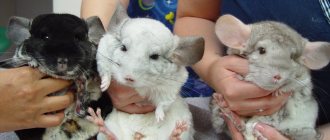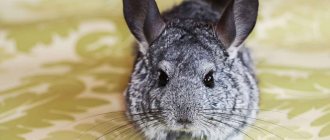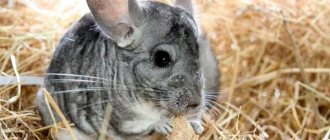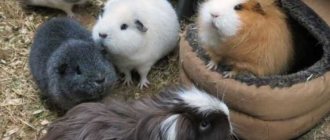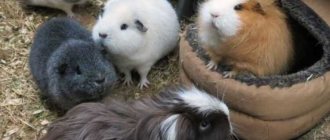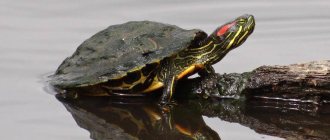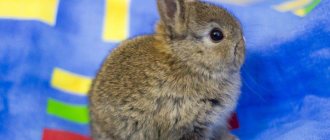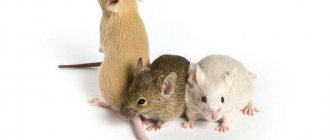Chinchillas are small animals from the order of rodents native to South America. Their habitat is the highlands of the South American Andes. Currently, there are very few chinchillas left in the wild; these animals were hunted for their fur, as a result of which the species is on the verge of extinction. Since the middle of the last century, chinchillas have been bred by amateurs as pets.
The chinchilla was first described by the English zoologist Edward Bennett in 1829.
Chinchilla - description and external characteristics
In appearance, the chinchilla resembles a large squirrel (they weigh from 300 to 800 g, and males are smaller than females), but in terms of its method of movement it is more like a rabbit. They have very thick, thin and soft fur, large dark eyes and large ears. The ears are the only organ of chinchillas that helps reduce body temperature - they are covered with a dense network of capillaries.
The body length of chinchillas is from 22 to 38 cm, the tail is 10-17 cm. The hind legs are longer than the front legs, thanks to which their movement resembles the jumping of a rabbit. Number of toes: four on the hind limbs, five on the front limbs. The front legs can make grasping movements.
The number of teeth reaches 20, and they grow throughout life. Therefore, it is very important for chinchillas to be able to chew something.
Baby chinchillas have white teeth, but adult chinchillas have orange teeth.
Social structure and reproduction
Photo: Chinchilla in nature
So, it was already said earlier that chinchillas are social animals that prefer to live in a group, in which they form their pairs. These rodents are monogamous, their unions are quite strong and long-lasting. The undisputed leading position in the family is occupied by the female. The female is ready for procreation already at six months of age, and males mature longer, becoming sexually mature only by 9 months. Chinchillas give birth several times a year (2 – 3).
The pregnancy period lasts for three and a half months. A pregnant female gains significant weight, and as birth approaches, she generally becomes inactive. Usually only one or two babies are born, very rarely – three. Tiny creatures that are already quite formed and look like their parents are born. From birth, the cubs already have a fluffy coat, sharp teeth and keen, curious eyes; they even know how to move.
Babies weigh from 30 to 70 g, it depends on how many of them were born. After just one week from the moment of birth, babies begin to try plant food, but continue to receive mother's milk until they are two months old. Chinchilla mothers are very caring and affectionate towards their children. These rodents are considered low-bearing, compared to their other relatives. In addition, the birth rate of young females is another 20 percent lower than that of experienced individuals. One chinchilla can usually give birth to up to 3 babies per year.
Where do chinchillas live in the wild?
Chinchillas are found in the wild in the dry mountainous regions of Bolivia, Argentina and Chile. In these zones, the temperature in summer does not exceed +24 C, and in winter it drops to -20 C. The climate is dry, windy and cold. It is thanks to these living conditions that chinchillas have very valuable and thick fur.
The vegetation in the area where wild chinchillas live is quite sparse. Mostly cacti, shrubs, some cereal plants and herbs grow there. Such living conditions affected the diet of these animals. Their incredibly long intestines allow them to extract nutrients from fairly meager food. In an adult animal, the length of the small and large intestines reaches 3.5 m. Wild chinchillas feed only on plant foods: branches and bark of shrubs, succulents, dry herbs and leaves.
Chinchillas live in groups and are nocturnal. Up to hundreds of animals can live in one group. During the day they hide in natural shelters, such as crevices in rocks or in burrows dug by other animals. To protect against predators, the colony always has “observers” who warn the whole family about the danger with loud sounds.
Chinchillas are nocturnal animals, their large eyes and long sensitive whiskers (vibrissae) allow them to move unerringly in the dark.
In natural conditions, chinchillas form pairs. They produce one offspring per year. There are usually 2-4 cubs in a litter.
Unfortunately, at present the number of wild animals is very small, only about ten thousand. In 2008, the long-tailed chinchilla was declared a critically endangered species. And the short-tailed chinchilla, unfortunately, is an endangered species.
What sounds do chinchillas make?
In nature, chinchillas live in groups and have developed a way of communicating with sounds. Their range ranges from a soft and quiet purr to a sharp whistle:
- mating rumbling calls of the male to mate;
- squeaking of babies - a demand for mother's attention or food;
- protest - sharp sounds that chinchillas make when quarreling or warning of danger;
- Chinchillas make very sharp and high-pitched sounds when angry, in a state of severe fright or when feeling pain.
How many years does a domestic chinchilla live?
Chinchillas are unusually active animals; they really like to jump, run and play. Life expectancy in captivity depends on how they are kept. How long can a chinchilla live at home? If you pay attention to their diet, keep the animals in a spacious cage, and give them the opportunity to communicate and move, then they can live quite a long time: eight to ten years or more.
Interesting Facts
- Chinchillas are perhaps the only animals whose life expectancy in captivity is shorter than in their natural habitat.
- To ensure that pets are properly cared for and fed, pet owners usually try to match the animal's life stages to the human life stages. There is no single formula that will determine the age of a chinchilla by human standards. It is generally accepted that the age of 1 month in rodents corresponds to 6 months in humans, 6 months - 14-16 years, 10-12 years - 40-45 years, and 20 years - 75 years.
- The beauty of chinchilla fur prompted breeders to develop new species of other animals with similar fur. This is how the breed of chinchilla rabbits and British chinchilla cats appeared.
- Chinchillas do not shed in the usual sense of the word. A complete change of coat occurs once in young individuals; subsequently, the coat is renewed daily by the loss of some of the old hairs.
Character
By nature, chinchillas are very affectionate and tame; they almost never bite. The animal can bite only in a state of severe fright. All chinchillas are different, some like to be petted and others not so much, and these character traits need to be respected. What chinchillas do not tolerate is violence. In order to achieve mutual understanding with the animal, you need to show patience and persistence, and respect the peculiarities of its character and behavior.
After purchasing a chinchilla, you need to leave it alone for about a week and let it get used to its new place. Then, unpersistently, you need to extend your hand to her with a treat. If the chinchilla wants, she will come up, take the treat and climb into your arms. If not, you need to continue taming it day after day until the animal gets used to you.
A chinchilla may become offended if you leave it alone for a long time or simply do not pay attention to it. She won't want to play with you and won't even take treats from your hands.
Chinchillas are very good at manipulating their owners. They know exactly what needs to be done to get what they want: they will sit in a corner and look at you with sad eyes, or they will jump on their hind legs to get a treat or go for a walk around the room.
Games and physical activity
These are very playful and active animals that simply love to walk around the apartment. A chinchilla will never miss an opportunity to sneak out of its cage and go explore the world. And considering that this is a rodent, after such entertainment for your pet you will find chewed shoes, sofa upholstery and wires. Also, an animal, frightened by a loud sound, can hide under a closet, from where it will be very difficult to get it out.
So experts do not recommend letting your chinchilla out of its cage, but rather purchasing a running wheel to satisfy its active needs. As a last resort, you can fence off an area on the floor in which your pet can frolic without causing damage to the apartment.
Chinchilla in a running wheel
Is it possible to train a chinchilla to go to the litter tray?
Chinchillas are very smart and learn quickly. It is very easy to train them to go to the litter box: place it in the cage in the place where the animal usually goes to the toilet, you need to remove all the bedding and wipe the floor of the cage with lemon. The chinchilla will immediately understand what needs to be done.
Tray
The second method: at first allow the animal to go to the toilet on the entire bedding at the bottom of the cage, but gradually reducing it every day. When a small patch remains, replace it with a small tray. The main thing is to change the bedding every day so that the cage is always dry.
Description of the species
Classification
There are several erroneous beliefs regarding the question: what species does a chinchilla belong to? Many people think that a chinchilla is a squirrel, rabbit or rat. In fact, it is an animal related to:
- kingdom - Animals;
- tipu - Chordata;
- class - Mammals;
- infraclass - Placental;
- squad - Rodents;
- suborder - Porcupines;
- superfamily - Chinchilla-like;
- family - Chinchilla;
- family - Chinchillas.
The chinchilla genus is divided into 2 species:
- Chinchilla lanigera - small long-tailed or shore;
- Chinchilla Brevicaudata - short-tailed or large.
There are mutational species that differ in hair color.
Habitats
The homeland of the animals is South America. Long-tailed individuals are widespread in the mountains of Chile. Short-tailed - live in the Andes and northwestern Argentina.
The habitat of rodents is rocky areas, preferably northern slopes. You can meet a rodent at an altitude of up to 5,000 m. Animals choose narrow cracks and openings between stones as a home and can dig a hole.
Chinchilla color
The natural color of chinchillas is gray, but not uniform; they have a dark back and a white belly. The color can vary in saturation from light gray to almost black.
Amateurs have bred numerous color variations: white, black, beige, brown and others. There are also purple chinchillas, although their color is not exactly purple, but gray with a bluish or light purple tint. In total, there are about 240 different shades of domestic chinchilla color.
White-pink color
Tricolor color
Golden color
Completely black color
Purple color
Chinchillas with light colored fur
Chinchillas with a white coat simply look luxurious and elegant. They have a number of unusual shades.
White Wilson
Chinchillas have white fur mixed with white or beige. You can purchase such an animal at a nursery or from breeders at home. The color is in demand among connoisseurs of these rodents.
Albino
These chinchillas do not have color pigments at the genetic level, so they have a snow-white tint and a red iris.
White lova
Chinchillas have white fur with a slight cream tint and dark ruby eyes.
White velvet
These animals have light fur that is velvety to the touch. Boy chinchillas often have a silver tint, while girls have a beige tint. In addition, they have distinctive gray spots on the head and limbs.
White-pink
The description of these chinchillas is as follows. Animals with milky white fur, pinkish ears and beady black eyes. However, there are representatives of this species that have a pink stripe on the back.
Diet
Chinchillas are quite delicate animals, and their diet at home must be selected very carefully. What do chinchillas eat? The main food for them is dry hay (it must be properly dried, with a pleasant herbal smell).
Fresh, high-quality hay should always be in the cage. If there is not enough hay, the animal may die.
In addition to hay, the chinchilla is fed with special food, and the following are suitable complementary foods: cereal flakes, dried leaves, herbs or roots, corn and flax seed, dried pieces of vegetables. These animals happily gnaw on branches of fruit trees and bushes: apple, cherry, raspberry or currant trees. The main thing is that everything is dry and free of moisture.
Chinchillas need to be given water. Make sure the water is always fresh.
A responsible attitude to the selection of chinchilla nutrition prolongs their life; more than half of the animals die prematurely from intestinal disorders.
Keeping at home
Keeping and caring for chinchillas at home is not difficult. But there are some important conditions that must be adhered to. Chinchillas need spacious, wide cages, preferably high ones, similar to enclosures; the animals are very active and must move a lot. For one animal, a cage of the following dimensions is suitable: 100 cm high, 80 cm long and 50 cm wide.
Chinchillas love to climb to heights, so it is advisable to give them this opportunity by installing wooden shelves in the cage. There is no need for ladders to connect floors, as chinchillas love to jump. In addition to shelves, it is advisable to install in the cage: a spacious wooden house, hammocks, tunnels and a running wheel.
Chew toys are also needed. These could be: small branches, wooden blocks, salt or chalk stone.
When choosing a cage, pay attention to the presence of plastic parts; they should not be in the cage, because... chinchillas chew and eat everything, and plastic can cause intestinal obstruction and death of the animal.
In addition, the chinchilla needs to be let out of the cage for a couple of hours a day, but at the same time monitored, since they like to chew everything that comes their way, including wires and furniture.
The bottom of the cage can be left clean, without filler, and in the corner of the cage you can install a tray where the chinchilla will go to the toilet.
Chinchillas are strictly prohibited from bathing in water! To clean their coats, they bathe in sand. Sand for this purpose should be used very fine and clean.
A container of sand can be placed in and next to the cage several times a week. There is no need to leave it on for a long time, as bathing chinchillas too often can cause dry skin.
If there is no filler at the bottom of the cage, then the cage should be swept daily with a small broom, removing excrement. It is advisable to wipe the shelves daily with natural detergents.
From whom did they come?
The prehistoric ancestors of chinchillas are considered to be animals called Meegamys by scientists. Their fossilized remains were found during excavations in the habitats of modern rodents. The age of the finds is about 40 thousand years. The biological structure of Meegamys is similar to chinchillas, but their size is much larger.
Based on the results of the excavations, a hypothesis was built that explains not only the origin of chinchillas, but also the unique properties of the animal’s fur. According to the researchers, during the process of evolution there was a gradual decrease in the size of individuals, but the number of hair follicles remained the same. As a result of these changes, the hair follicles on the skin of chinchillas are much denser than in other animals.
The closest relatives of chinchillas are porcupines, and the closest relatives in biological structure are considered to be viscacha, a genus from the chinchilla family.
Chinchilla health
A healthy adult animal should weigh at least 500 g. You also need to pay attention to the color of the teeth. If teeth begin to turn white, losing their orange color, this is the first sign of calcium deficiency. The fur should be smooth and shiny.
People often ask whether a chinchilla needs special care. No special care is needed, but it is better to contact a veterinarian if you notice that your animal:
- refuses food;
- lethargic and passive;
- falls over on its side.
In the room where the animal lives, the air temperature should be no higher than 26 degrees. High air temperatures can cause heatstroke in a chinchilla.
Chinchillas with dark fur
These rodents include black velvet chinchillas with rich black fur and a white belly.
Black velvet
This color combines black and white. The animals have a black body and tail, and a white belly. This contrast looks very impressive and the clearer the color boundaries, the higher the price of a chinchilla and the more valued the breed is.
This species of rodent was bred in the 60s of the last century. Breeders believe that the dark skin is evidence of the high quality of the breed. Chinchillas may have light stripes on their limbs, a charcoal mask, and dark fur on their heads.
The older a rodent gets, the more pronounced its breed characteristics become. Since the black fur gene is lethal, crossing with representatives of your own breed is unacceptable; black chinchillas can only be mated with rodents of other colors.

